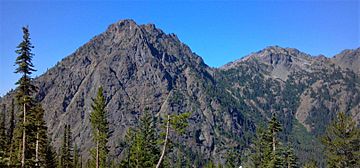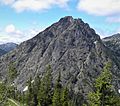Esmeralda Peaks facts for kids
Quick facts for kids Esmeralda Peaks |
|
|---|---|

Esmeralda Peaks, east aspect
|
|
| Highest point | |
| Elevation | 6,765 ft (2,062 m) |
| Prominence | 765 ft (233 m) |
| Isolation | 1.67 mi (2.69 km) |
| Parent peak | Ingalls Peak (7,662 ft) |
| Geography | |
| Location | Kittitas County Washington, U.S. |
| Parent range | Wenatchee Mountains Cascade Range |
| Topo map | USGS Mount Stuart |
| Climbing | |
| Easiest route | class 2 scrambling |
Esmeralda Peaks is a tall mountain in Washington state, standing at 6,765 ft (2,060 m) high. It's not just one peak, but actually has several tops, making it a 'multi-summit' mountain. You can find it in Kittitas County, within the Wenatchee Mountains.
It's located near other mountains like Ingalls Peak and Hawkins Mountain, and is part of the land looked after by the Wenatchee National Forest. When rain or snow falls on the peaks, the water flows down into streams that eventually join the Teanaway River. The mountain's name used to be spelled Esmerelda Peaks sometimes, but in 1966, the U.S. Board on Geographic Names officially decided it should be spelled Esmeralda.
Mountain Weather
The area around Esmeralda Peaks is on the eastern side of the Cascade Mountains. This means it's a bit drier here compared to places on the western side.
During summer, the weather can be warm, and you might even see some thunderstorms. Most of the weather systems, like big clouds that bring rain, start over the Pacific Ocean. They then travel east towards the Cascade Mountains.
When these weather systems hit the tall peaks of the Cascades, the air is forced to rise. As the air goes higher, it cools down and drops its moisture as rain or snow. This process is called Orographic lift. Because of this, the western slopes of the Cascades get a lot more rain and snow than the eastern slopes, making the eastern side drier.
In winter, the weather is usually cloudy. But in summer, high-pressure systems over the Pacific Ocean often bring clear skies with little to no cloud cover.
Images for kids
-
Esmeralda Peaks, with Hawkins upper left






